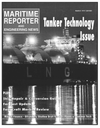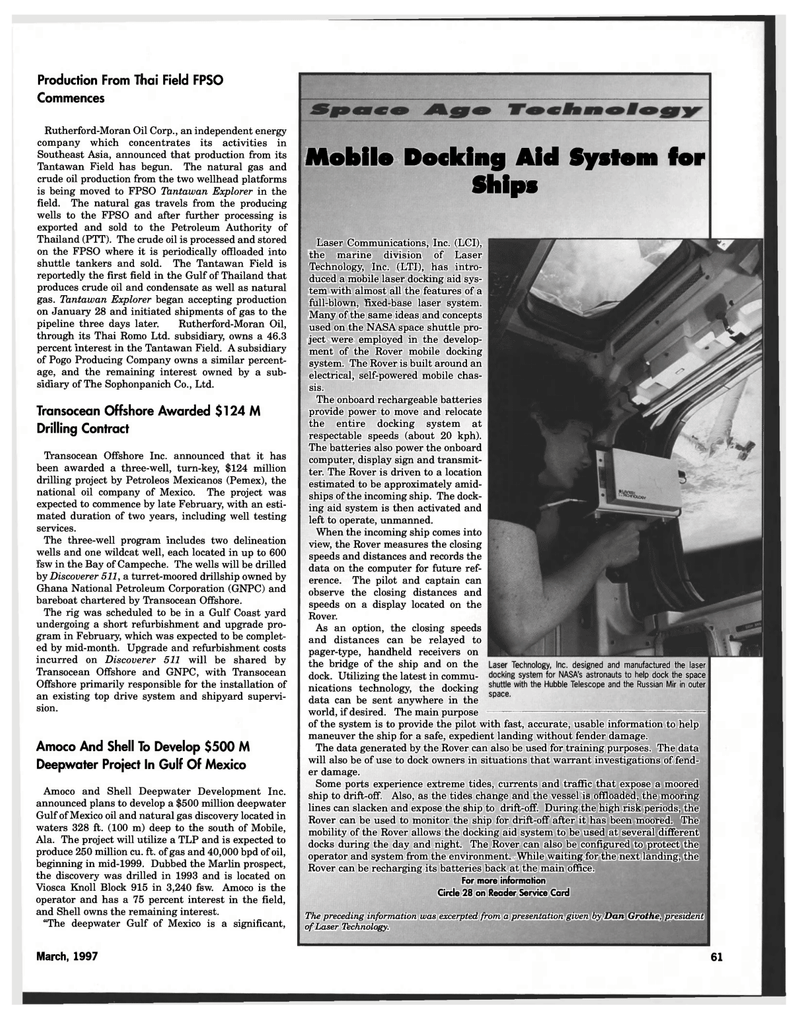
Page 53: of Maritime Reporter Magazine (March 1997)
Read this page in Pdf, Flash or Html5 edition of March 1997 Maritime Reporter Magazine
Production From Thai Field FPSO
Commences
Rutherford-Moran Oil Corp., an independent energy company which concentrates its activities in
Southeast Asia, announced that production from its
Tantawan Field has begun. The natural gas and crude oil production from the two wellhead platforms is being moved to FPSO Tantawan Explorer in the field. The natural gas travels from the producing wells to the FPSO and after further processing is exported and sold to the Petroleum Authority of
Thailand (PTT). The crude oil is processed and stored on the FPSO where it is periodically offloaded into shuttle tankers and sold. The Tantawan Field is reportedly the first field in the Gulf of Thailand that produces crude oil and condensate as well as natural gas. Tantawan Explorer began accepting production on January 28 and initiated shipments of gas to the pipeline three days later. Rutherford-Moran Oil, through its Thai Romo Ltd. subsidiary, owns a 46.3 percent interest in the Tantawan Field. A subsidiary of Pogo Producing Company owns a similar percent- age, and the remaining interest owned by a sub- sidiary of The Sophonpanich Co., Ltd.
Transocean Offshore Awarded $ 124 M
Drilling Contract
Transocean Offshore Inc. announced that it has been awarded a three-well, turn-key, $124 million drilling project by Petroleos Mexicanos (Pemex), the national oil company of Mexico. The project was expected to commence by late February, with an esti- mated duration of two years, including well testing services.
The three-well program includes two delineation wells and one wildcat well, each located in up to 600 fsw in the Bay of Campeche. The wells will be drilled by Discoverer 511, a turret-moored drillship owned by
Ghana National Petroleum Corporation (GNPC) and bareboat chartered by Transocean Offshore.
The rig was scheduled to be in a Gulf Coast yard undergoing a short refurbishment and upgrade pro- gram in February, which was expected to be complet- ed by mid-month. Upgrade and refurbishment costs incurred on Discoverer 511 will be shared by
Transocean Offshore and GNPC, with Transocean
Offshore primarily responsible for the installation of an existing top drive system and shipyard supervi- sion.
Amoco And Shell To Develop $500 M
Deepwater Project In Gulf Of Mexico
Amoco and Shell Deepwater Development Inc. announced plans to develop a $500 million deepwater
Gulf of Mexico oil and natural gas discovery located in waters 328 ft. (100 m) deep to the south of Mobile,
Ala. The project will utilize a TLP and is expected to produce 250 million cu. ft. of gas and 40,000 bpd of oil, beginning in mid-1999. Dubbed the Marlin prospect, the discovery was drilled in 1993 and is located on
Viosca Knoll Block 915 in 3,240 fsw. Amoco is the operator and has a 75 percent interest in the field, and Shell owns the remaining interest. "The deepwater Gulf of Mexico is a significant,
Mobile Docking Aid System for
Ships
Laser Communications, Inc. (LCI), the marine division of Laser
Technology, Inc. (LTI), has intro- duced a mobile laser docking aid sys- tem with almost all the features of a full-blown, fixed-base laser system.
Many of the same ideas and concepts used on the NASA space shuttle pro- ject were employed in the develop- ment of the Rover mobile docking system. The Rover is built around an electrical, self-powered mobile chas- sis.
The onboard rechargeable batteries provide power to move and relocate the entire docking system at respectable speeds (about 20 kph).
The batteries also power the onboard computer, display sign and transmit- ter. The Rover is driven to a location estimated to be approximately amid- ships of the incoming ship. The dock- ing aid system is then activated and left to operate, unmanned.
When the incoming ship comes into view, the Rover measures the closing speeds and distances and records the data on the computer for future ref- erence. The pilot and captain can observe the closing distances and speeds on a display located on the
Rover.
As an option, the closing speeds and distances can be relayed to pager-type, handheld receivers on the bridge of the ship and on the dock. Utilizing the latest in commu- nications technology, the docking data can be sent anywhere in the world, if desired. The main purpose of the system is to provide the pilot with fast, accurate, usable information to help maneuver the ship for a safe, expedient landing without fender damage.
The data generated by the Rover can also be used for training purposes. The data will also be of use to dock owners in situations that warrant investigations of fend- er damage.
Some ports experience extreme tides, currents and traffic that expose a moored ship to drift-off. Also, as the tides change and the vessel is offloaded, the mooring lines can slacken and expose the ship to drift-off. During the high risk periods, the
Rover can be used to monitor the ship for drift-off after it has been moored. The mobility of the Rover allows the docking aid system to be used at several different docks during the day and night. The Rover can also be configured to protect the operator and system from the environment. While waiting for the next landing, the
Rover can be recharging its batteries back at the main office.
For more information
Circle 28 on Reader Service Card
The preceding information was excerpted from a presentation given by Dan Grothe, president of Laser Technology.
Laser Technology, Inc. designed and manufactured the laser docking system for NASA's astronauts to help dock the space shuttle with the Hubble Telescope and the Russian Mir in outer space.
March, 1997 61

 52
52

 54
54
